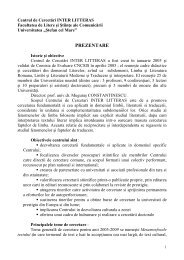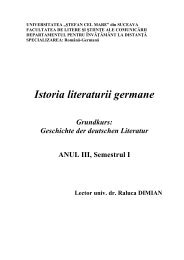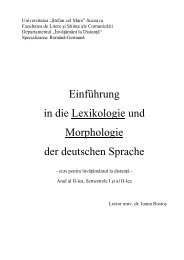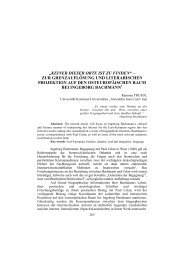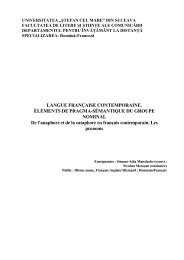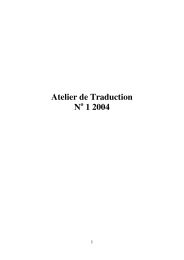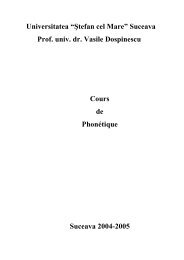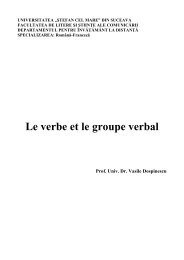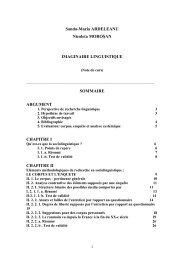Le discours de la francophonie
Le discours de la francophonie
Le discours de la francophonie
You also want an ePaper? Increase the reach of your titles
YUMPU automatically turns print PDFs into web optimized ePapers that Google loves.
Laura A.-Popovici & Ione<strong>la</strong> G.-Bândiul – The Didactic Speech…In the first instance, the visible one, the teacher, emitter ofthe didactic speech, has to establish the construction axes for thedidactic approach, the achieving targets for the teaching-learningprocess, such as the exp<strong>la</strong>nation, illustration, argumentation, trans<strong>la</strong>tion,reformu<strong>la</strong>tion, making and remaking the sens of knowledgeobjects. Secondly, implicitely the teacher becomes the director,psychologist, coordinator, actor, mediator and producer ofsocial and psychological signs, especially of signs leading to semiosis.The paratext as a construction element for the communicativearea activates the intervention of the didactic emitter, corre<strong>la</strong>tingit with that of the recipient in a perpetual process of semiosis.The emitter’s re<strong>la</strong>tionship with the paratext is based on establishingan intervention system in or<strong>de</strong>r to activate the paratextualconstruction, a system composed of semiotic operations such as:rhetorical acts, proxemics, gestures, mimicry, psycho-pedagogy(pronunciation of words in a certain way to call upon the recipient’sattention, using a vocal timbre to seduce the recipient,using the semiotic silence for composing moments of suspense, ofwaiting for what ist o follow, eg: now let’s see who can apply themo<strong>de</strong>l we introduced to you in the following exercise, generousand <strong>la</strong>rge hand gestures signifying altruism, kindness, communication,sometimes directed to orient the recipient’s sight to an objectfor analysing, combined with an open, positive, emotionalmimicry).The paratextual didactic speech benefits from the attribute of„mimicry, by the fact that the recipient is invited to participate inthe composition/ restoration of text’s world based on the <strong>de</strong>tailsoffered by the author.” (BORNEDAL, Peter, 1997:150) (extrapo<strong>la</strong>tionof R. Ohmann’s affirmation re<strong>la</strong>ted to literary speech).The didactic speech, through the paratext of the communicativearea, achieves by its unpredictability, a creative communication,surpassed by the intrinsic meaning of the text, <strong>la</strong>unching ahypothesis which is inten<strong>de</strong>d to outline paratext which appearssubsequent to the text.17



